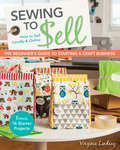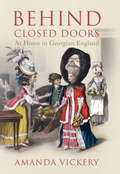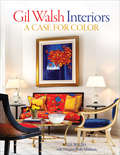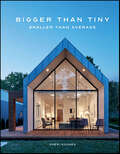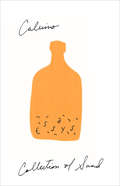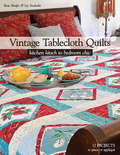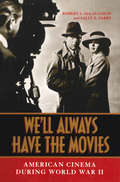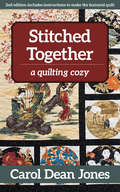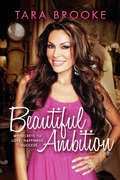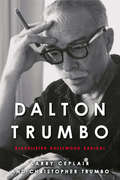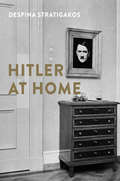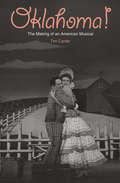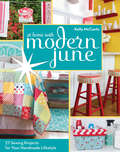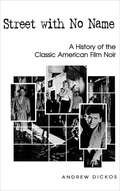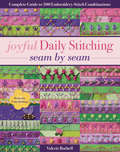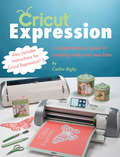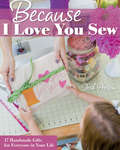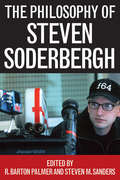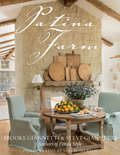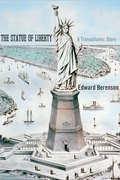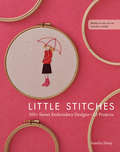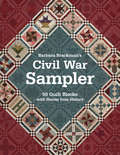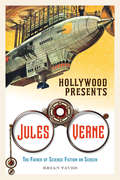- Table View
- List View
Trailerama: 1000 Piece Puzzle
by Phil NoyesPhotos, postcards, and ads featuring vintage trailers—from humble family vacations to Hollywood stars. Trailerama provides a visual wonderland filled with imagery featuring these vintage vehicles, fondly recalled for their associations with fun, adventure, family vacations—and of course, movie stars on the set. From greeting cards to postcards to Hollywood photos, the travel trailer is put on grand display in this kitschy celebration culled from the coffers of Trailer Travel&’s Phil Noyes. &“Filled with colorful images of trailers. Culled from ads, postcards, sheet music, and more, they run the gamut from the earliest mobile coaches in the 1930s to the roving behemoths that came to dominate the market in later decades…Noyes documents the country&’s still smoldering love affair with life on the road.&”—Los Angeles Magazine
Sewing to Sell: How To Sell Locally & Online; The Beginner's Guide to Starting a Craft Business
by Virginia LindsayThe creator of Gingercake Patterns shows you how to share your passion for sewing with the world by starting a successful home business. Maybe you started sewing just for fun. But now you&’ve developed the skills and vision to turn your creative outlet into something more. Making the leap from hobbyist to professional can be intimidating—but Virginia Lindsay is here to help you get off the sidelines and sew your way to a job you truly enjoy. Drawing on her own experience, Lindsay guides you through every aspect of starting your own craft business, from finding your personal sewing style to creating a product line, identifying customers, equipping your studio, pricing and selling your work, marketing yourself, designing your own patterns, and handling the business and legal side of sewing. And that's not all! Virginia also shares 16 projects (all customer-tested) that you can personalize to start sewing and selling right now.
Behind Closed Doors: At Home in Georgian England
by Amanda VickeryFrom the award-winning author of The Gentleman&’s Daughter,a witty and academic illumination of daily domestic life in Georgian England. In this brilliant work, Amanda Vickery unlocks the homes of Georgian England to examine the lives of the people who lived there. Writing with her customary wit and verve, she introduces us to men and women from all walks of life: gentlewoman Anne Dormer in her stately Oxfordshire mansion, bachelor clerk and future novelist Anthony Trollope in his dreary London lodgings, genteel spinsters keeping up appearances in two rooms with yellow wallpaper, servants with only a locking box to call their own.Vickery makes ingenious use of upholsterer&’s ledgers, burglary trials, and other unusual sources to reveal the roles of house and home in economic survival, social success, and political representation during the long eighteenth century. Through the spread of formal visiting, the proliferation of affordable ornamental furnishings, the commercial celebration of feminine artistry at home, and the currency of the language of taste, even modest homes turned into arenas of social campaign and exhibition.The basis of a 3-part TV series for BBC2.&“Vickery is that rare thing, an…historian who writes like a novelist.&”—Jane Schilling, Daily Mail&“Comparison between Vickery and Jane Austen is irresistible…This book is almost too pleasurable, in that Vickery's style and delicious nosiness conceal some seriously weighty scholarship.&”—Lisa Hilton, The Independent&“If until now the Georgian home has been like a monochrome engraving, Vickery has made it three dimensional and vibrantly colored. Behind Closed Doors demonstrates that rigorous academic work can also be nosy, gossipy, and utterly engaging.&”—Andrea Wulf, New York Times Book Review
Gil Walsh Interiors: A Case for Color
by Gil Walsh Margaret Reilly MuldoonThe award-winning interior designer and owner of Gil Walsh Interiors shares her colorful approach to style in this beautifully illustrated volume. Master colorist Gil Walsh has spent decades bringing her expertise to elegant homes from Pennsylvania to West Palm Beach, Martha&’s Vineyard, and beyond. Now she brings readers into her creative process, showing how she helps clients express their personal lifestyles through inviting and gorgeously vibrant interiors. With stunning photography, this volume demonstrates how color can be enjoyed with gusto, whether in pretty pastels or bold, bright hues. From beach houses in the Florida Keys to sky-scraping apartments in Palm Beach, historic landmark buildings such as Fallingwater and the Duquesne Club in Pennsylvania, and a cozy cottage on Martha&’s Vineyard, Gil has applied her artistic eye and techniques to a wide variety of interiors and period styles.
Bigger Than Tiny, Smaller Than Average
by Sheri KoonesSmaller, more environmentally-friendly houses seem to be the wave of the future. As people chose to move out of cities, finances and life style will limit the size of the houses these new home owners will choose. This book includes lots of examples of small house options around the country, including ADUs (accessory dwelling units). Whether you’re building a small house, renovating an older home, or purchasing something new, this book will provide inspiration. It compiles lots of previously difficult-to-find information in one place. The sidebars describe home systems and new materials helpful to any homeowner concerned about the environment and hoping to save money on energy and maintenance.
Collection of Sand: Essays (Penguin Modern Classics Ser.)
by Italo CalvinoThis &“brilliant collection of essays&” and travelogues by the celebrated author of Invisible Cities &“may change the way you see the world around you&” (The Guardian, UK). Italo Calvino&’s boundless curiosity and ingenious imagination are displayed in peak form in Collection of Sand, his last collection of new works published during his lifetime. Delving into the delights of the visual world—both in art and travel—the subjects of these 38 essays range from cuneiform and antique maps to Mexican temples and Japanese gardens. In Calvino&’s words, this collection is &“a diary of travels, of course, but also of feelings, states of mind, moods…The fascination of a collection lies just as much in what it reveals as in what it conceals of the secret urge that led to its creation&” (from Collection of Sand). Never before translated into English, Collection of Sand is an incisive and often surprising meditation on observation and knowledge, &“beautifully translated by Martin McLaughlin&” (The Guardian, UK).
Vintage Tablecloth Quilts: Kitchen Kitsch to Bedroom Chic
by Liz Aneloski Rose SheiferPreserve memories and create new family heirlooms—by transforming gorgeous vintage tablecloths into beautiful quilts! Dig into grandma&’s attic, visit a flea market, buy new reproduction panels…even old tablecloths with holes or stains can become part of a lovely quilt. With clear guidance and photos, learn how to convert the best parts of each cloth into quilt blocks and appliqué elements that can be combined with commercial fabrics for extra vibrancy. Customize your design to get the most out of any tablecloth—parcel out a single cloth for multiple projects, or combine pieces of different cloths into one quilt. &“Blue roses in rows, red cherries in bunches, brown pots and pans in golden squares—anyone who has ever been enticed by the colors and styles of vintage tablecloths, like ones produced in the 1920s by Wilendur, will be further delighted by the thought of quilting them…[The authors] cite fabric requirements, measurements, colors, and they clearly describe blocks, construction, and borders with clean graphics for finishing these beauties.&”—Publishers Weekly
We'll Always Have the Movies: American Cinema During World War II
by Sally E. Parry Robert L. McLaughlinAn &“essential&” study of what Americans watched during wartime, and how films shaped their understanding of events (Publishers Weekly).During the highly charged years of World War II, movies perhaps best communicated to Americans who they were and why they were fighting. These films were more than just an explanation of historical events: they asked audiences to consider the Nazi threat; they put a face on both our enemies and allies, and they explored changing wartime gender roles.We&’ll Always Have the Movies shows how film after film repeated the narratives, character types, and rhetoric that made the war and each American&’s role in it comprehensible. Robert L. McLaughlin and Sally E. Parry have watched more than six hundred films made between 1937 and 1946—including many never before discussed in this context—and have analyzed the cultural and historical importance of these films in explaining the war to moviegoers. This extensive study shows how filmmakers made the chaotic elements of wartime familiar, while actual events became film history, and film history became myth.&“A terrific book that explores not only the themes of hundreds of films but also their impact on patriotism and national will in a time of war.&” —WWII History
Stitched Together: A Quilting Cozy (A\quilting Cozy Ser. #5)
by Carol Dean JonesIn this mystery featuring a bonus quilting pattern, a retiree moves her romance to the next level—while at the same time trying to untangle a murder… Years ago, a policeman named Charles came to Sarah Miller&’s door to break the sad news to her that her husband had died. Little did Sarah know that one day, she would move into the Cunningham Village retirement community—and run into Charles again. Their friendship has grown into something more, and they&’re currently dealing with the joys—and challenges—of combining households. But amid this activity, they and their friends have to pull together to defend one of their own accused of murder… Includes a bonus quilting pattern!
Beautiful Ambition: My Secrets to Love, Happiness & Success
by Tara BrookeIn this mix of memoir and motivational guide, a model and businesswoman shares how she overcame personal trials to achieve love, happiness, and success. Today author Tara Brooke lives life with passion, but it wasn&’t always that way. In Beautiful Ambition, she describes her painful childhood, her parents&’ divorce, her mother&’s ill health, and the bullying and humiliation she endured at the many different schools she was forced to attend because of their many moves. Never settling for the life she was born into and training herself to believe in the impossible, Tara, through hard work and self-discipline, set out on a path of personal growth and development. In this must-have book, Tara provides a step-by-step approach on how to go about life, how to embrace, be, and do who and what you are and want to be—all while staying true to yourself and remaining dedicated to making things happen and to having your dreams become reality. The core message being: You can do anything in life that you put your head, heart and mind to! &“Tara is an amazing example that no matter how difficult your childhood is…you can still have a warm loving heart, a love of life, and a spiritual light that will guide you into becoming a wonderful person…the kind that Tara has become today.&”—Michael King, CEO, King World Productions
Dalton Trumbo: Blacklisted Hollywood Radical (Screen Classics)
by Larry Ceplair Christopher Trumbo&“Trumbo emerges from this well-rounded biography as a larger-than-life figure, not unlike the characters he scripted for the screen.&” —Publishers Weekly James Dalton Trumbo is widely recognized as a screenwriter, playwright, and author, but he is also remembered as one of the Hollywood Ten who opposed the House Un-American Activities Committee. Refusing to answer questions about his prior involvement with the Communist Party, Trumbo sacrificed a successful career in Hollywood to stand up for his rights and defend political freedom. In Dalton Trumbo, Larry Ceplair and Christopher Trumbo present their extensive research on the famed writer, detailing his work; his membership in the Communist Party; his long campaign against censorship during the domestic cold war; his ten-month prison sentence for contempt of Congress; and his thirteen-year struggle to break the blacklist. The blacklist ended for Trumbo in 1960, when he received screen credits for Exodus and Spartacus. Just before his death, he received a long-delayed Academy Award for The Brave One, and in 1993, he was posthumously given another for Roman Holiday. This comprehensive biography, which includes excerpts of Trumbo&’s letters, notes, and other writings, also provides insights into the notable people with whom Trumbo worked, including Stanley Kubrick, Otto Preminger, and Kirk Douglas, and a fascinating look at the life of one of Hollywood&’s most prominent screenwriters and his battle against persecution.
Wild Spaces and Unique Places: Celebrating the Natural Wonders of Utah
by Ryan JefferyWith its sweeping valleys and towering mountains, its inviting summers and glittering snowscapes, its hiking trails and world-renowned ski slopes, Utah’s soaring heights are, indeed, where life is elevated. Explore these wild spaces through the dramatic and captivating photography of Ryan Jeffery, which captures Utah’s beloved wildness—the wildlife, the national parks, the desert vistas, and the mountains, all beautifully arrayed in splendor. Quotes from Utah authors such as Terry Tempest Williams, Edward Abbey, and Everett Ruess are spread throughout the scenes. Each page whisks you away to spaces like no other—where open skies kiss the silhouette of the landscape that rises to meet it.
Hitler at Home
by Despina StratigakosA look at Adolf Hitler&’s residences and their role in constructing and promoting the dictator&’s private persona both within Germany and abroad. Adolf Hitler&’s makeover from rabble-rouser to statesman coincided with a series of dramatic home renovations he undertook during the mid-1930s. This provocative book exposes the dictator&’s preoccupation with his private persona, which was shaped by the aesthetic and ideological management of his domestic architecture. Hitler&’s bachelor life stirred rumors, and the Nazi regime relied on the dictator&’s three dwellings—the Old Chancellery in Berlin, his apartment in Munich, and the Berghof, his mountain home on the Obersalzberg—to foster the myth of the Führer as a morally upstanding and refined man. Author Despina Stratigakos also reveals the previously untold story of Hitler&’s interior designer, Gerdy Troost, through newly discovered archival sources. At the height of the Third Reich, media outlets around the world showcased Hitler&’s homes to audiences eager for behind-the-scenes stories. After the war, fascination with Hitler&’s domestic life continued as soldiers and journalists searched his dwellings for insights into his psychology. The book&’s rich illustrations, many previously unpublished, offer readers a rare glimpse into the decisions involved in the making of Hitler&’s homes and into the sheer power of the propaganda that influenced how the world saw him.&“Inarguably the powder-keg title of the year.&”—Mitchell Owen, Architectural Digest&“A fascinating read, which reminds us that in Nazi Germany the architectural and the political can never be disentangled. Like his own confected image, Hitler&’s buildings cannot be divorced from their odious political hinterland.&”—Roger Moorhouse, Times
Oklahoma!: The Making of an American Musical (Broadway Legacies Ser.)
by Tim CarterThe backstage story of the timeless Broadway hit, and how Rodgers and Hammerstein brought it to life: &“Meticulously researched&” (Publishers Weekly). Oklahoma! premiered on Broadway in 1943 under the auspices of the Theatre Guild, and today it is performed more frequently than any other Rodgers and Hammerstein musical. In this book, Tim Carter offers the first fully documented history of the making of this celebrated American musical. Drawing on research from rare theater archives, manuscripts, journalism, and other sources, Carter records every step in the development of Oklahoma! The book is filled with rich and fascinating details about how Rodgers and Hammerstein first came together, the casting process, how Agnes de Mille became the show&’s choreographer, and the drafts and revisions that ultimately gave the musical its final shape. Carter also shows the lofty aspirations of both the creators and producers and the mythmaking that surrounded Oklahoma! from its very inception, and demonstrates just what made it part of its times.
At Home with Modern June: 27 Sewing Projects for Your Handmade Lifestyle
by Kelly McCantsFrom the author of Sewing With Oilcloth—brighten up your home with these sewing projects that are as easy on you as they are on your budget. Whether you're moving into a new home, launching a home makeover, or just sprucing up a room, this book, At Home With Modern June, by Kelly McCants, provides plenty of ideas on how to infuse individuality into every room in the house. The 27 budget-friendly projects have a retro style and use materials such as oilcloth, laminated cotton, and chalk cloth in addition to quilter's cotton. Easy-to-follow instructions and helpful photographs guide you to success. You'll make drapes, bed skirts, floor mats, and much more. All that's required is a bit of ingenuity, a little time, and some basic skills.&“This follow-up will be welcomed by [McCants&’s] readers eager for more of her bright, cheerful, and often-oilcloth-centered designs.&”—Publishers Weekly&“McCants…took her vintage modern aesthetic—think cheery 1950s housewife with a contemporary flair for design—and applied it to home decor. The result is this collection of fun sewing projects for the home, many featuring [her] beloved laminated cottons. Most of the projects are beginner-friendly and require little more than the ability to machine sew in a straight line, but there are a few for sewists looking for a challenge, such as the reupholstered bar stool.&”—Library Journal
Street with No Name: A History of the Classic American Film Noir
by Andrew DickosThis history of film noir explores the legacy and aesthetic roots of American filmmakers including Orson Welles, John Huston, Otto Preminger, and others. Flourishing in the United States during the 1940s and 50s, the bleak, violent genre of filmmaking known as film noir reflected the attitudes of writers and auteur directors influenced by the events of the turbulent mid-twentieth century. Films such as Force of Evil, Night and the City, Double Indemnity, Kiss Me Deadly and later on, Chinatown and The Grifters are indelibly American. Yet the sources of this genre were found in Germany and France and imported to Hollywood by emigré filmmakers. Andrew Dickos's Street with No Name traces film noir back to its roots in German Expressionist cinema and the French cinema of the interwar years. Dickos describes the development of film noir in America from 1941 through the 1970s, covering notable directors such as Orson Welles, Fritz Lang, John Huston, Nicholas Ray, Robert Aldrich, Samuel Fuller, Otto Preminger, Robert Siodmak, Abraham Polonsky, Jules Dassin, Anthony Mann and others. Dickos also charts the genre's influence on such celebrated postwar French filmmakers as Jean-Pierre Melville, François Truffaut, and Jean-Luc Godard. Addressing the aesthetic, cultural, political, and social concerns of its creators, Street with No Name demonstrates how film noir generates a highly expressive, raw, and violent mood as it exposes the ambiguities of modern postwar society.A Choice Outstanding Academic Title
Joyful Daily Stitching Seam by Seam: Complete Guide to 500 Embroidery-Stitch Combinations, Perfect for Crazy Quilting
by Valerie Bothell&“Anyone with an interest in needlework (beginners and experts alike) will make plenty of use of this nifty anthology of stitches.&”—Publishers Weekly Choose from over 500 crazy-quilt seam treatments, each with a detailed photo and guide for the basic stitches included. Learn 61 basic embroidery stitches, including silk ribbon and beaded stitches, through step-by-step photos, plus get crazy-quilt block piecing instructions and helpful information on tools and supplies. Then put it all together in a gorgeous, intricate sampler. Join the author&’s popular Facebook group, Joyful Embellishments, to stitch along with fellow embroiderers. &“Bothell, a crazy quilting specialist with more than 20 years of experience, helps others whose imaginations might fail when decorating the seams of quilts in this delightful collection of stitches.&”—Publishers Weekly
Cricut Expression: A Comprehensive Guide to Creating with Your Machine
by Cathie RigbyCreate amazing papercrafts with this comprehensive guide for beginners and advanced Cricut™ users. In a clear and accessible way, Cathie Rigby teaches the basics of the Cricut Expression™ machines (both the original and the new Cricut Expression™ 2) and cutting for beginners. For advanced crafters, this book instructs on features such as modes and functions, and teaches how to create with color, texture, and dimension. A cutting guide teaches the perfect settings to cut every type of material. A separate chapter introduces the new features of Cricut Expression™ 2 and explains how it differs from the original Expression machine. More than 50 creative projects inspire ideas for home décor, gifts, parties, cards, and scrapbook layouts. Cathie Rigby has taught Cricut, Design Studio, and Gypsy classes for four years in the Salt Lake City area. She currently teaches at Roberts Arts & Crafts and Hobby Lobby stores and hosts scrapbook retreats and Cricut Cruises.
Because I Love You Sew: 17 Handmade Gifts for Everyone in Your Life
by Trish PrestonUse your sewing superpower to create holiday, special occasion, and just because presents for moms, dads, kids, friends, and others! Don&’t just say it . . . sew it! Show everyone in your life how much you love them with this gift-making book, Because I Love You Sew, by Trish Preston. Its charming collection of 17 projects features quilts, stylish totes, pretty holiday decor, and more! Includes patterns for all skill levels, step-by-step directions, and plenty of inspiring ideas for making each gift even more personal. &“Inspires us anew to appreciate the &‘why&’ of these creations formed with our hands and hearts. We enjoyed the insight into Trish&’s family, her thoughts on gift giving and her lovely projects.&”—Generation Q Magazine &“Give the gift of handmade this holiday. Pick from vintage ice skate Christmas stockings and small projects, such as a fabric bicycle basket or a recipe binder cover. Or commemorate a special occasion with a wedding memories collage, birthday celebration shirt, and family tree crazy quilt.&”—Quilts & More
The Philosophy of Steven Soderbergh (The Philosophy of Popular Culture #Ppcs)
by R. Barton Palmer and Steven M. Sanders&“Provocative, insightful, and instructive analysis of the cinematic and philosophical significance of Steven Soderbergh&’s work.&” —Jason Holt, editor of The Daily Show and Philosophy: Moments of Zen in the Art of Fake News Widely regarded as a turning point in American independent cinema, Steven Soderbergh's sex, lies, and videotape launched the career of its twenty-six-year-old director, whose debut film was nominated for an Academy Award and went on to win the Cannes Film Festival&’s top award, the Palme d&’Or. The Philosophy of Steven Soderbergh breaks new ground by investigating salient philosophical themes through the unique story lines and innovative approaches to filmmaking that distinguish this celebrated artist. Editors R. Barton Palmer and Steven M. Sanders have brought together leading scholars in philosophy and film studies for the first systematic analysis of Soderbergh&’s entire body of work, offering the first in-depth exploration of the philosophical ideas that form the basis of the work of one of the most commercially successful and consistently inventive filmmakers of our time.
Patina Farm
by Brooke Giannetti Steve GiannettiThe husband and wife team behind Giannetti Home welcome readers into their gorgeous farm residence blending modern style with French antiques. When Brooke and Steve Giannetti decided to leave their suburban Santa Monica home to build a new life on a farm, they traveled to Belgium and France for design inspiration. In Patina Farm they share their collaborative process, as well as the enviable result of their team effort and creativity: an idyllic farm in California&’s Ojai Valley. With two hundred gorgeous photographs and Steve&’s architectural drawings, Brooke takes readers through their inspirations, thought process, and materials selections. Readers are given a full tour of the family home, guesthouse, lush gardens, and delightful animal quarters.
The Statue of Liberty: A Transatlantic Story (Icons of America)
by Edward Berenson&“If you think you know all there is to know about the Statue of Liberty, you&’ll be pleasantly surprised.&”—The New York Times When the crated monument first arrived in New York Harbor, few could have foreseen the central place the Statue of Liberty would come to occupy in the American imagination. In this book, cultural historian and scholar of French history Edward Berenson tells the little-known stories of the statue&’s improbable beginnings, transatlantic connections, and the changing meanings it has held for each successive generation. He tells of the French intellectuals who decided for their own domestic political reasons to pay tribute to American liberty; the initial, less-than-enthusiastic American response; and the countless difficulties before the statue was at last unveiled to the public in 1886. The trials of its inception and construction, however, are only half of the story. Berenson also shows how the statue&’s symbolically indistinct, neoclassical form has allowed Americans to interpret its meaning in diverse ways—as representing the emancipation of the slaves, Tocqueville&’s idea of orderly liberty, opportunity for &“huddled masses,&” and, in the years since 9/11, the freedom and resilience of New York City and the United States in the face of terror.Includes photos and illustrations &“Endlessly fascinating.&”—Louisville Courier-Journal
Little Stitches: 100+ Sweet Embroidery Designs, 12 Projects
by Aneela HoeyOver 100 embroidery designs and twelve whimsical and practical projects you can work on anywhere.It's grown-up playtime! Choose from more than 100 original embroidery designs, hand-drawn with a modern take on retro style. Aneela Hoey's illustrations are printed on transfer paper to use and reuse―tear out the page, trim out the design, iron it down, and stitch away! Learn 11 easy decorative stitches plus techniques for adding texture, then embroider these charming images on 12 whimsical and practical projects, perfect for keepsakes or gifts. Projects include a baby quilt, cushion covers, cozies for jars and tissue boxes, and more. Embroidery is the perfect handwork to take along anywhere you go!&“Hoey&’s cute, vintage-inspired approach will appeal to novice stitchers.&”—Library Journal&“These designs have ageless appeal…The book is extra useful with the iron-on transfers for each design included in the back of the book.&”—American Quilt Retailer
Barbara Brackman's Civil War Sampler: 50 Quilt Blocks with Stories from History
by Barbara BrackmanWitness Civil War history chronicled in quilt squares, discover more about the women behind them, and learn how to craft a quilt of your own. Journey through a historic time in American history with Barbara Brackman, bestselling author and quilt historian. Barbara's book features fifty quilt blocks that commemorate the 150th anniversary of the Civil War. Each block (most were first published in the 1930s) was selected for the symbolism its name lends to recounting stories from the era&’s women. This compilation of quilt block patterns includes period photos and first-person accounts. Choose from pieced or appliquéd blocks, each in two colorways with instructions for 8&” and 12&” sizes. Dig into your reproduction fabrics and enjoy combining blocks to make your own tribute quilt.&“This is another lovely book of Barbara&’s to add to the collection.&”—Australian Quilters Companion
Hollywood Presents Jules Verne: The Father of Science Fiction on Screen (Screen Classics)
by Brian TavesAn &“illuminating&” look at how filmmakers have taken us around the world, under the sea, and to the center of the earth over the course of a century (Milwaukee Express). Even for those who have never read Jules Verne, the author&’s very name conjures visions of the submarine in Twenty Thousand Leagues Under the Sea, the epic race in Around the World in Eighty Days, the spacecraft in From the Earth to the Moon, and the daring descent in Journey to the Center of the Earth. One of the most widely translated authors of all time, Verne has inspired filmmakers since the early silent period and continues to fascinate audiences more than a century after his works were first published. His riveting plots and vivid descriptions easily transform into compelling scripts and dramatic visual compositions. In Hollywood Presents Jules Verne, Brian Taves investigates the indelible mark that the author has left on English-language cinema. Adaptations of Verne&’s tales have taken many forms—early movie shorts, serials, feature films, miniseries, and television shows—and have been produced as both animated and live-action films. Taves illuminates how, as these stories have been made and remade over the years, each new adaptation looks back not only to Verne&’s words but also to previous screen incarnations. He also examines how generations of actors have portrayed iconic characters such as Phileas Fogg and Captain Nemo, and how these figures are treated in pastiches such as Journey 2: The Mysterious Island. Investigating the biggest box-office hits as well as lower-budget productions, this comprehensive study will appeal not only to fans of the writer's work but also to readers interested in the ever-changing relationship between literature, theater, and film.

